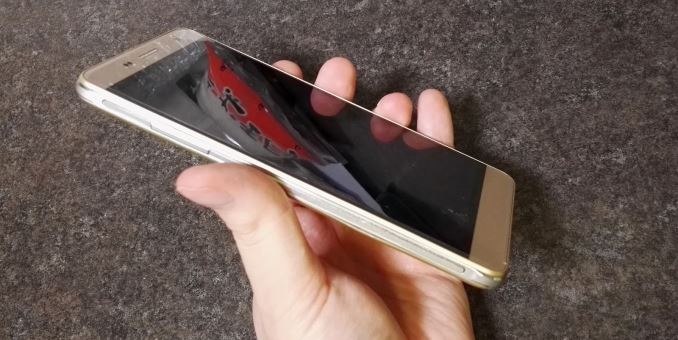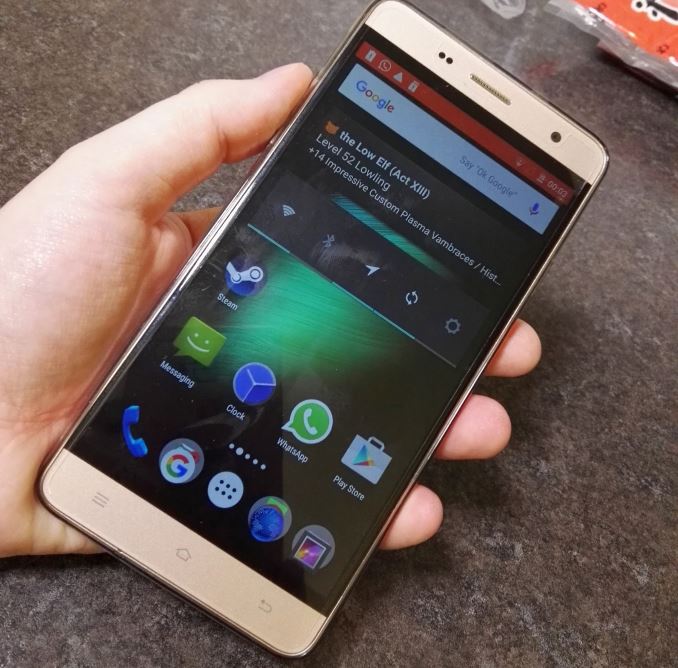The CUBOT H1 Smartphone Test: A Month with 3-4 Days of Battery per Charge
by Ian Cutress on December 23, 2015 9:01 AM EST- Posted in
- Smartphones
- Mobile
- Battery
- CUBOT
Final Words
I'll be brutally honest - while I keep a good tab on some elements of the smartphone market, more so on the business side, when it comes to deep dive analysis I leave it in the hands of Josh, Andrei and Brandon. That doesn't mean I don't need a device though, and despite their suggestions it seems I wanted a lot and wasn't prepared to spend the money. As a technical editor, my search for a smartphone caused a series of positive and negative feedback loops - some days I'd decide that DRAM was the most important, whereas others it would be the display resolution or the storage capacity. In the end it comes down to compromise and what is good and within range at the time I was looking. At one point I was adamant I wanted something more powerful than a Snapdragon 600 series, but I've ended up with a quad core MediaTek A53 device running at low frequency. There were some no-brainers – it had to be big enough and good enough to work on when I have short 20 minute public transport trips, and support dual SIM so I don’t have to keep losing my SIM card each time I travel.
The CUBOT H1 was the result of the search. It’s a smartphone that boasts 5200 mAh of battery, which is 3.4x the size of the battery in the iPhone 5c or 2x the battery in the Galaxy S6. When combined with the 1280x720 screen and the 1 GHz quad-core SoC, it gave 4 days of standard use battery which translated to 15 hours and 26 minutes on the PCMark battery test that runs from 100% to 20%, beating the Zenfone 2 by over nine hours. That is pretty much pre-2000 smartphone territory, more akin to what we used to have when playing games like Snake.
My smartphone use case has adapted over time – I want it to do work on. That means writing, switching between apps, being somewhat responsive, and always being available. The SoC means it doesn’t break any sort of record for performance, but ultimately so much of my use doesn’t require performance but rather latency in app switching and updates. Having enough memory to keep apps available means a lot, so moving up from 1GB to 2GB was a big enough change to notice, as well as the bump up to Android 5.1. The 16GB storage model is pretty basic, and the microSD compatibility is only at 32GB, rather than something bigger, and I know it will fill over time with the consistent photographing of my cats. But that is a risk that I’m going to have to take, or synchronize with Dropbox.
Without the silicone case that comes free with the phone, I will grant that despite the patterned edge, it does feel like the plastic the rear is made from, and arguably it slips out of the hand too easily. With the silicone case, it just feels like a smartphone with a case, which a lot of people use anyway. The raised power and volume buttons helps discern their location, and the fixed buttons is something I like to have on my device, even if it means giving up screen real estate.
It is clear that the cameras are not for taking glamour shots. But at a trade show, as long as you are in the front row, and have a second or two between shots, taking pictures of slides to work on later is good enough. To get a good shot taking advantage of the EIS though, you really need to use the burst mode which supports 40 shots at 13 MP each. The video is also an afterthought. That comes down to the price and what needs to be cut to meet that price. I purchased the device, brand new from Amazon, for £125 which translates to $160 pre-tax. Almost everyone I showed the phone to, probably due to the battery life argument, thought it was more expensive. The only people who guessed under (and only by $10) were a pair of senior ARM employees. But truth be told, I could buy four of these a year and it would still be cheaper than an S6. Of course, there are obvious caveats with that comparison.
I would say that this is going to be my phone for the next two years. But since I purchased it in October, two extra high end smartphones that others at AnandTech have tested have both landed on my desk for similar experiential testing. It almost seems sad to shelve the Cubot H1 immediately unless I adapt to carry two phones at once, with the H1 as that long-battery backup.
| CUBOT H1 | ||
| SoC | Mediatek MT6735P 4x ARM Cortex-A53 at 977 MHz ARM Mali-T720 MP2 at 400 MHz |
|
| RAM | 2GB LPDDR3 at 533 MHz | |
| Storage | 16GB NAND | |
| Display | 5.5” 720p IPS | |
| Modem | 2G / 3G / 4G LTE UE Category 4 DC-HSPA+, TD-SCDMA, CDMA2000 1x/EVDO Rev. A, EDGE |
|
| Networks |
TDD LTE | None |
| FDD LTE | B1 / B3 / B7 / B20 | |
| UMTS | 900 / 1900 / 2100 | |
| GSM | 850 / 900 / 1800 / 1900 | |
| Dimensions | 154.5 (h) x 76.6 (w) x 9.2 (d) mm, 201 grams* Weight Measured by AnandTech, conflicting numbers online |
|
| Cameras | Rear | 12.8MP ( 4128 x 3096 ) |
| Front | 8MP ( 3264 x 2448 ) | |
| Battery | 5200 mAh (19.76 Whr) | |
| OS | Android 5.1 | |
| Connectivity | 802.11a/b/g/n 2.4GHz BT 4.0, GPS, A-GPS, Micro-USB |
|
| SIM Size | Micro-SIM (FDD-LTE, WCDMA, GSM) Nano-SIM (GSM Only) Also Separate MicroSD slot, up to 32GB |
|
| MSRP (UK) | 16GB | $160
£125 as purchased |
So the final question becomes ‘how is it pronounced?’ Do we say cue-bot? Or perhaps cub-bot, or cue-bow? After writing this review, and looking at their online ‘CUBOT enterprise propaganda film’ on YouTube, it turns out to be coo-bot.












116 Comments
View All Comments
jjj - Wednesday, December 23, 2015 - link
Retail price vs cost is the easiest way to measure and the point is that ratio is much much better with some Chinese phones while Apple is pretty much the worse. You can get a Xiaomi Redmi Note 2 that has a retail price close to cost or a Nexus at about 2x, the iphone is at 4x or worse.The reported margins are slightly misleading but not getting into that here. As for costs after the factory's gate, that's not exactly the buyers problem if a device maker chooses to be less efficient than others.
Daniel Egger - Wednesday, December 23, 2015 - link
3 letters from me: LOL. The requirements and expectations driving this article are a solid start but give it a few more years and even journalists will become sane.Anywhoo: My last pre-smartphone phone (Nokia 6310i) regularly lasted north of 3 weeks. My current Moto E (2015) with its small 2390mAh battery typically lasts 9 or 10 days in my usage pattern which is the first smartphone since I'm using smartphones which I find acceptable in that regard since I stored my trusty Nokia in the drawer. I'm certainly not going to accept any less for any successor.
yannigr2 - Wednesday, December 23, 2015 - link
It is amazing what the Chinese companies offer in the smartphone market. It is also amazing how much time it took most western tech sites to start exploring those devices.If you don't need the best of the best in every category, there is no reason today to spend more than 100-150 euros/dollars/pounds for a dual sim smartphone with one of the latest versions of Android and a pretty nice IPS screen.
pSupaNova - Sunday, December 27, 2015 - link
Not only smartphones but tablets too.Chinese manufacturers look like they are going through the same path as the Japanese in electronic goods.
First the cheap copies then the real innovations.
Can Anandtech start reviewing their Windows and Android tablets?
Yaldabaoth - Wednesday, December 23, 2015 - link
"The 16GB storage model is pretty basic, and the microSD compatibility is only at 32GB, rather than something bigger, and I know it will fill over time with the consistent photographing of my cats."More pictures of Summer and Cici, please.
KPOM - Wednesday, December 23, 2015 - link
I take it you rarely travel to the US, Ian? That phone is practically useless even for voice here. It doesn't support any US 3G band (much less LTE). AT&T and T-Mobile are rapidly turning off their 2G networks to make room for LTE. They expect to be finished on January 1, 2017.yannigr2 - Wednesday, December 23, 2015 - link
This is not planet USA.Pissedoffyouth - Wednesday, December 23, 2015 - link
Who cares if it doesn't work in the USA? Don't buy itbeggerking@yahoo.com - Wednesday, December 23, 2015 - link
every gsm phone work in USA.most works with 3/4g as well.
some works with LTE (only because we SUCK and STUPID and use different band than the rest of the world).
KPOM - Wednesday, December 23, 2015 - link
@beggerking, on January 1, 2017, AT&T plans to turn off its 2G GSM network. The phone in question does not support AT&T or T-Mobile's 3GSM bands. As for LTE, apart from the iPhone 6S there aren't many "universal" LTE phones out there (and even that isn't universal), since China, Australia, the US, South America, the EU, etc. all use different bands. It's a matter of available spectrum. Heck, each of the carriers in the US use different LTE bands.